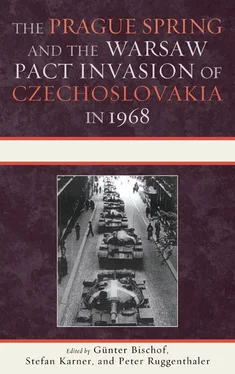3. SAPMO-BA, DY 30/3616, pp. 182–207, report of the Department for International Ties, “Zur Reaktion in der kommunistischen Weltbewegung auf die Ereignisse in der ČSSR,” to the office of W. Ulbricht, 11 April 1968, reprinted in Karner et al., Dokumente , #162.
4. The name originated in July when the CPSU, the BCP, the PUWP, the HSWP, and the SED sent a joint letter to the KSČ following the Warsaw Conference.
5. Hermann Wentker, Außenpolitik in engen Grenzen: Die DDR im internationalen System 1949–1989 (Munich: Oldenbourg, 2007).
6. Zdenek Hejzlar, Reformkommunismus: Zur Geschichte der Kommunistischen Partei der Tschechoslowakei (Cologne: Europäische Verlagsanstalt, 1976), 146.
7. Peter Florin, born 1921, was of the “Moscow cadre” and son of Wilhelm Florin (KPD). In 1935 he emigrated to the Soviet Union, in 1942 completed an apprenticeship at the School of the Communist International, in 1943/1944 was a partisan in Belarus, in May 1945 returned to Berlin, from 1952 to 1966 served as head of the Department for Foreign Affairs in the Central Committee of the SED, and from 1958 to 1989 was a member of the Central Committee of the SED.
8. SAPMO-BA, DY 30/3616, pp. 52–57, report of the GDR ambassador in the ČSSR, P. Florin, on the situation in the country, 10 March 1968, reprinted in Karner et al., Dokumente , #3 (reprinted in appendix 1 of this volume).
9. Rudé pravo , report of the Central Committee of the KSČ regarding the alteration of the authority of the Central Publication Administration, 6 March 1968, reprinted Karner et al., Dokumente , #2.
10. Zu den Ereignissen in der Tschechoslowakei: Tatsachen, Dokumente, Presse-und Augenzeugenberichte (Moscow: Pressegruppe Sowjetischer Journalisten, 1968), 3.
11. “Defamation of the revolutionary power as a ‘totalitarian dictatorship’ and the related demand for ‘pluralism’ and the ‘democratization’ of power under socialism serve them as the main means for the ideological preparation and implementation of counter-revolution.” Rudolf Dau et al., eds., Wörterbuch des wissenschaftlichen Kommunismus (East Berlin: Dietz, 1982), Stichwort: Konterrevolution , 216. Further keywords, which are characteristic for “counterrevolution” are anticommunism, anti-Soviet, and nationalism. Anticommunism: “Wesenszug und Grundtendenz der gesamten Ideologie und Politik des Imperialismus im Kampf gegen den Sozialismus, gegen die revolutionäre Arbeiterbewegung und den Marxismus-Leninismus, gegen die Friedensbewegung und alle anderen demokratischen Kräfte” ( Stichwort: Antikommunismus , 26). Anti-Soviet: “dominierendes Kennzeichen des Antikommunismus. Er richtet sich gegen die Sowjetunion, gegen deren führende Kraft—die KPdSU—, gegen Politik, Wirtschaft, Ideologie und Kultur des sowjetischen Staates. Der Antisowjetismus entstand als konterrevolutionäre Reaktion auf die Entstehung des ersten sozialistischen Staates in der Welt. Er zielt auf die Diskreditierung und Vernichtung der sowjetischen Gesellschaft” ( Stichwort: Antisowjetismus , 30). Nationalism: “ist eine ‘bürgerliche Ideologie,’ im Zusammenhang mit dem Ost-West-Kon-flikt bekommt er eine spezifische Bedeutung: Mit Hilfe des Nationalismus sollen die politisch-ideologischen Grundlagen des Sozialismus in einzelnen Ländern untergraben, die Einheit der sozialistischen Gemeinschaft und der kommunistischen und Arbeiterparteien durch die Leugnung allgemeisngültiger Gesetzmäßigkeiten, die Überbetonung nationaler Besonderheiten und nationalistischer Ideen zerstört werden” ( Stichwort: Nationalismus , 270–71).
12. SAPMO-BA, DY 30/11834, pp. 1–271, stenographical record of the consultation of the five “sister parties” with the KSČ in Dresden, 23 March 1968, reprinted in Karner et al., Dokumente , #75.
13. A. J. Wyschinski (Vyshinsky), Gerichtsrede (East Berlin: Dietz Verlag, 1952), 545, and Wladislaw Hedeler, Chronik Moskauer Schauprozesse 1936, 1937, und 1938 (Berlin: Akademie Verlag, 2003).
14. RGANI, F. 3, op. 72, d. 155, p. 5, Politburo resolution of the Central Committee of the CPSU P 74 (II), 15 March 1968, reprinted in Karner et al., Dokumente , #73.
15. RGANI, F. 3, op. 72, d. 157, pp. 6 and 15–19, Politburo resolution of the Central Committee of the CPSU P 76 (12), 23 March 1968, reprinted in Karner et al., Dokumente , #30.
16. On this, see Lutz Priess et al., Die SED und der “Prager Frühling” (Berlin: Akademie Verlag, 1995), 63–64.
17. Rudolf Helmer, KPD member since 1931, since 1959 served as head of the Department for Neighboring Countries of the Ministry for Foreign Affairs of the GDR.
18. RGANI, F. 5, op. 60, d. 299, pp. 108–13, taken from the official diary of the embassy counsel of the USSR in the GDR, V. P. Grenkov, 19 March 1968, reprinted in Karner et al., Dokumente , #6.
19. Quoted from Priess et al., Die SED und der “Prager Frühling,” 172–73. On this, see also Békés, “Hungary and the Prague Spring,” in this volume.
20. RGANI, F. 3, op. 72, d. 154, p. 2, Politburo resolution of the Central Committee of the CPSU P 73 (1), 11 March 1968, reprinted in Karner et al., Dokumente , #72; RGANI, F. 3, op. 72, d. 155, p. 5, Politburo resolution of the Central Committee of the CPSU P 74 (II), 15 March 1968, reprinted in Karner et al., Dokumente , #73. On this, see also Békés, “Hungary and the Prague Spring,” in this volume.
21. RGANI, F. 3, op. 72, d. 154, p. 2 (see note 20) and SAPMO-BA, DY 30/11834, S. 1–271 (see note 12); all quotes that follow are from these minutes.
22. Jan Pauer writes about how Dubček and his delegation dealt with the confrontation in Dresden: “Neither the Party leadership nor the public learnt anything about the conflict and about possible verbal undertakings on the part of the KSČ delegation to the effect that they wanted to bring developments more in line with Soviet intentions.” Jan Pauer, Prag 1968, Der Einmarsch des Warschauer Paktes: Hintergründe—Planung—Durchführung (Bremen: Ed. Temmen, 1995), 43–44.
23. SAPMO-BA, DY 30/3617, pp. 17–19 and 26–32, internal Bulgarian information passed on to the GDR and other participants at the Dresden meeting, 30 March 1968, reprinted in Karner et al., Dokumente , #21.
24. SAPMO-BA, DY 30/3617, pp. 17–19 and 26–32.
25. SAPMO-BA, DY 30/3616, pp. 1–16 and 46, text of the speech of Comrade Josef Smrkovský on the plenum of the Central Committee of the KSČ, 1 February 1968, reprinted in Karner et al., Dokumente , #1.
26. This is a reference to a survey by the Literární listy on basic questions relating to current affairs, on the importance of free elections, a functioning parliament, an opposition, and active neutrality. Ulbricht commented on the last point with the statement “no more Warsaw Pact then.”
27. Kurt Hager (1912–1998) was a participant in the Spanish Civil War, in 1955 was secretary of the Central Committee of the SED for Culture and Science, was a 1958 nominee, and from 1963 until 1989 served as a member of the Politburo.
28. See Priess et al., Die SED und der “Prager Frühling , ” 81–94.
29. RGANI, F. 5, op. 60, d. 299, pp. 298–307, report of the Soviet ambassador in the GDR, P. Abrasimov, to the departmental head of the Central Committee of the CPSU, K. V. Rusakov, “Zur Frage der Beziehungen zwischen der SED und der KPČ, der DDR und der Tschechoslowakei,” 19 April 1968, reprinted in Karner et al., Dokumente , #16.
30. Otto Winzer (1902–1975) was in 1925 a KPD member, a member of the Comintern, emigrated to the Soviet Union, in 1945 returned to Berlin as a member of the “Ulbricht Group,” and from 1965 to 1975 served as foreign minister of the GDR.
Читать дальше












